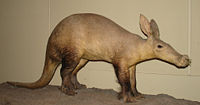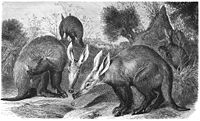Aardvark
- For other uses, see Aardvark (disambiguation).
{{#invoke:Message box|ambox}}
| Aardvark | ||||||||||||||||
|---|---|---|---|---|---|---|---|---|---|---|---|---|---|---|---|---|
 | ||||||||||||||||
| Scientific classification | ||||||||||||||||
| ||||||||||||||||
| Orycteropus afer (Pallas, 1766) | ||||||||||||||||
 Aardvark range map
|
The Aardvark (Orycteropus afer) ("Digging foot"), sometimes called "antbear"[1] is a medium-sized mammal native to Africa. The name comes from the Afrikaans/Dutch for "earth pig" (aarde earth, varken pig), because early settlers from Europe thought it resembled a pig. However, the Aardvark is not closely related to pigs, being placed in its own order.
Description
The most distinctive characteristic of the Tubulidentata is (as the name implies) their teeth, which, instead of having a pulp cavity, have a number of thin tubes of dentine, each containing pulp and held together by cementum. The teeth have no enamel coating and are worn away and regrow continuously. The Aardvark is born with conventional incisors and canines at the front of the jaw, but these fall out and are not replaced. Adult Aardvarks have only molars at the back of the jaw.
The Aardvark is only vaguely pig-like; the body of the aardvark is sparsely scattered with coarse hairs; the body is stout with an arched back; the limbs are of moderate length. The front feet have lost the pollex (or 'thumb') — resulting in four toes — but the rear feet have all five toes. Each toe bears a large, robust nail which is somewhat flattened and shovel-like, and appears to be intermediate between a claw and a hoof. The ears are disproportionately long, and the tail is very thick at the base and gradually tapers. The greatly elongated head is set on a short, thick neck, and the end of the snout bears a disc, which house the nostrils. The mouth is small and tubular, typical of species that feed on termites. The aardvark has a long, thin, protrudable tongue and elaborate structures supporting a keen sense of smell.
An aardvark's weight is typically between 40 and 65 kg; length is usually between 1 and 1.3 meters, and can reach lengths of 2.2 meters[1] when its heavy tail (which can be up to 70 centimeters)[1] is taken into account. The aardvark is a pale yellowish gray in color, often stained reddish-brown by soil. The coat is thin and the animal's primary protection is its tough skin; the aardvark has been known to sleep in a recently excavated ant nest, so well does it protect them.
Behavior
The Aardvark is nocturnal and is a solitary creature that feeds almost exclusively on ants and termites (formicivore); the only fruit eaten by aardvarks is the aardvark cucumber. An aardvark emerges from its burrow in the late afternoon or shortly after sunset, and forages over a considerable home range encompassing 10 to 30 kilometers,[1] swinging its long nose from side to side to pick up the scent of food. When a concentration of ants or termites is detected, the Aardvark digs into it with its powerful front legs, keeping its long ears upright to listen for predators, and takes up an astonishing number of insects with its long, sticky tongue — as many as 50,000 in one night have been recorded. It is an exceptionally fast digger, but otherwise moves fairly slowly. Its claws enable it to dig through the extremely hard crust of a termite mound quickly, avoiding the dust by sealing the nostrils. When successful, the aardvark's long (as long as 30 centimeters)[1] tongue licks up the insects; the termites's stinging attacks are rendered futile by the tough skin. Its keen hearing warns it of predators: lions, leopards, hyenas, and pythons.
Aside from digging out ants and termites, the aardvark also excavates burrows in which to live: temporary sites are scattered around the home range as refuges, and a main burrow is used for breeding. Main burrows can be deep and extensive, have several entrances and can be as long as 13 meters. The Aardvark changes the layout of its home burrow regularly, and from time to time moves on and makes a new one; the old burrows are then inhabited by smaller animals like the African Wild Dog.[1]. Only mothers and young share burrows. If attacked in the tunnel, it will seal the tunnel off behind itself or turn around and attack with its claws.
Aardvarks only pair during certain breeding seasons; after a gestation period of 7 months, a single cub weighing around 2 kg is born, and is able to leave the burrow to accompany its mother after only two weeks, and is eating termites at 14 weeks and is weaned by 16 weeks.[1] At six months of age it is able to dig its own burrows, but it will often remain with the mother until the next mating season, and is sexually capable by the season after that.
Aardvarks can live to be over 24 years old in captivity.[1]
The aardvark's main predators are lions, leopards, hunting dogs and pythons. Aardvarks can dig fast or run in zigzag fashion to elude enemies, but if all else fails, they will strike with their claws, tail and shoulders, sometimes flipping onto their backs to lash with all fours. Their thick skin also protects them to some extent.
Habitat
Aardvarks live south of the Sahara desert where there is suitable habitat for them to live. Aardvarks live in African savannas, grasslands, woodlands and bush. They are not found in deserts but are found in places where there is a lot of food supply (ants and termites). Aardvarks dig burrows (holes in the earth) as homes.
Notes and references
Knothig, J. 2005. Biology of the aardvark (Orycteropus afer). Ruprecht-Karls-Universität Heidelberg (Ruprecht Karl University of Heidelberg. Retrieved September 14, 2007.
- African Wildlife Foundation. 2007. Aardvark. African Wildlife Foundation. Retrieved September 14, 2007.
- P. Lindsey et al 2006. [1]. 2006 IUCN Red List of Threatened Species., World Conservation Union. Retrieved on 11 May 2006. Database entry includes justification for why this species is of least concern
- Aardvarks: Wildlife summary from the African Wildlife Foundation
- Schlitter, D. A. 2005. In D. E. Wilson and D. M. Reeder, eds. Mammal Species of the World: A Taxonomic and Geographic Reference, 3rd edition. Baltimore: Johns Hopkins University Press. ISBN 0801882214.
| Mammals |
|---|
| Monotremata (platypus, echidnas) |
|
Marsupialia: | Paucituberculata (shrew opossums) | Didelphimorphia (opossums) | Microbiotheria | Notoryctemorphia (marsupial moles) | Dasyuromorphia (quolls and dunnarts) | Peramelemorphia (bilbies, bandicoots) | Diprotodontia (kangaroos and relatives) |
|
Placentalia: Cingulata (armadillos) | Pilosa (anteaters, sloths) | Afrosoricida (tenrecs, golden moles) | Macroscelidea (elephant shrews) | Tubulidentata (aardvark) | Hyracoidea (hyraxes) | Proboscidea (elephants) | Sirenia (dugongs, manatees) | Soricomorpha (shrews, moles) | Erinaceomorpha (hedgehogs and relatives) Chiroptera (bats) | Pholidota (pangolins)| Carnivora | Perissodactyla (odd-toed ungulates) | Artiodactyla (even-toed ungulates) | Cetacea (whales, dolphins) | Rodentia (rodents) | Lagomorpha (rabbits and relatives) | Scandentia (treeshrews) | Dermoptera (colugos) | Primates | |
Credits
New World Encyclopedia writers and editors rewrote and completed the Wikipedia article in accordance with New World Encyclopedia standards. This article abides by terms of the Creative Commons CC-by-sa 3.0 License (CC-by-sa), which may be used and disseminated with proper attribution. Credit is due under the terms of this license that can reference both the New World Encyclopedia contributors and the selfless volunteer contributors of the Wikimedia Foundation. To cite this article click here for a list of acceptable citing formats.The history of earlier contributions by wikipedians is accessible to researchers here:
The history of this article since it was imported to New World Encyclopedia:
Note: Some restrictions may apply to use of individual images which are separately licensed.

